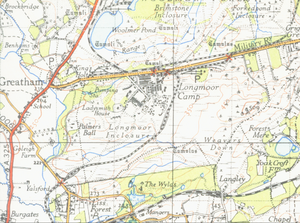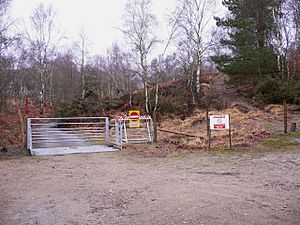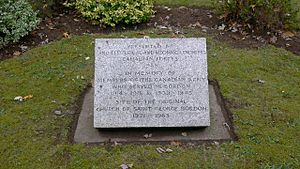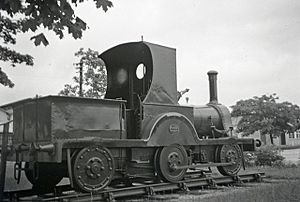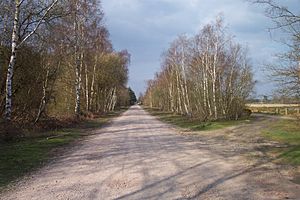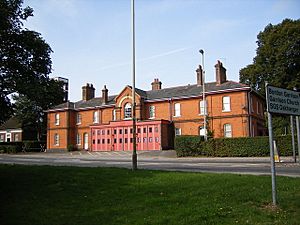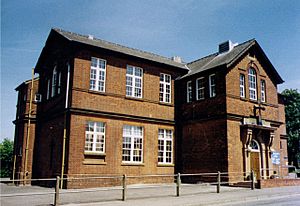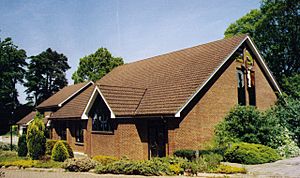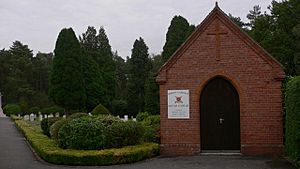Bordon and Longmoor Military Camps facts for kids
Quick facts for kids Bordon and Longmoor Military Camps |
|
|---|---|
| Bordon and Longmoor | |
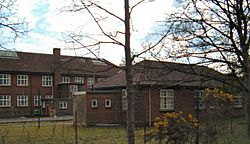
Modern brick barracks at Longmoor
|
|
|
Location within Hampshire
|
|
| Coordinates | 51°4′23″N 0°52′8″W / 51.07306°N 0.86889°W |
| Type | Barracks |
| Site information | |
| Owner | Ministry of Defence |
| Operator | |
| Site history | |
| Built | 1863 |
| Built for | War Office |
| In use | 1863–Present |
The Bordon and Longmoor Military Camps are important training areas for the British Army. They are located near the towns of Bordon, Longmoor, Liss, and Liphook in Hampshire, England. The main road through Longmoor Camp follows an ancient Roman road. These camps and their training areas cover a huge 1,783 hectares (4,410 acres) (about 4,400 acres) of forests, open heathland, wetlands, and paved areas. Longmoor Camp is still active today and is looked after by the Defence Infrastructure Organisation.
Contents
History of the Camps
Why Were the Camps Built?
Back in 1863, the War Department (which managed the army) needed more space to train British Army soldiers. They bought a large area of land, about 781 acres (316 ha) (316 hectares), at Hogmoor Inclosure and Longmoor. However, the main army base was at Aldershot Garrison, which was 20 miles (32 km) away. This meant soldiers had to march a long way or take an expensive train. They often camped overnight in tents.
So, the army decided to build two permanent camps closer to Woolmer Forest. The plan was to build 140 wooden huts at each site, big enough for 5,000 soldiers. Work started on Bordon Camp in 1899. Then, the Second Boer War slowed things down. So, the army began working on Longmoor Camp in August 1900. Building materials were brought by train. Heavy vehicles damaged the roads, which led to the first tests of lorries with pneumatic tyres for the British Army!
Early 1900s: Naming and Moving Huts
In 1902 and 1903, the War Department bought even more land. They decided to name the camps at Longmoor after famous battles from the Boer War. The officers' homes were named after commanders like Amherst and Wolfe. The barracks at Bordon were named after battles and places from the Seven Years' War in North America. This is why the first two camps were called St. Lucia and Quebec, starting a long connection with Canada.
The first soldiers arrived at Quebec barracks in Bordon Camp in April 1903. They were the Somersetshire Light Infantry. Soon after, the 2nd Battalion Devonshire Regiment joined them. They marched from Bentley train station with a marching band.
In May 1903, the first soldiers moved into Longmoor Camp. But the camp was built on swampy ground. Soldiers complained about problems and health issues. So, the War Department quickly decided to move 68 of the Longmoor huts to Bordon Camp, about 4 miles (6.4 km) to 6 miles (9.7 km) away.
This big move of huts was finished in May 1905. It created the Gaudaloupe and Martinique barracks at Bordon. This meant Bordon could house a full infantry brigade (a large group of soldiers).
The first brick buildings started in 1906 and finished in 1907. These were called Louisburg Barracks. They were built for artillery regiments and a riding school. There was even a veterinary hospital for sick horses. Later, in 1911, more buildings and stables were added for the Royal Engineers.
First World War: Canadian Army's Role
During the First World War, the Canadian Army used Bordon as a place to train troops before they went into battle. Soldiers arrived by ship in Glasgow and Liverpool, then took trains directly to Bordon. The Canadians first lived in tents, setting up camps named after the Great Lakes like Erie and Huron. The Canadian Forestry Corps even set up a steam-powered saw mill nearby.
Between the World Wars
In the 1920s, more land was bought for training. In the 1930s, new brick barracks were built. This meant the old wooden huts at Quebec and St Lucia barracks were taken down. A new wooden hut training camp was also built at Oxney Farm, called Martinique barracks.
Second World War: Canadians Return
In 1939, at the start of World War II, the British 3rd Infantry Brigade left Bordon to join the British Expeditionary Force. They left from Liss train station on special trains to Southampton Docks.
When the Canadian Army needed a base in Europe, the British Army offered them Bordon and Longmoor Military Camps. The Canadians took over completely from September 1939. They built two new sub-camps using wooden huts that were built in Canada and shipped over:
- Oakhanger Camp: After the war, this camp was used to sell extra army vehicles. It was taken down around 1950.
- Lower Oakhanger Camp: This camp was used by the Canadians until D-Day. After that, it became a German prisoner of war camp. Later, it was used by European workers. The huts were taken down, and the concrete bases were used for helicopter landing practice by RAF Odiham.
The Canadians also built many security points and anti-aircraft bases around Bordon. Tanks and armoured cars were parked there, and you can still see the old concrete slabs today. The Canadians had their own fire station, and they also helped staff the main army fire station.
After the Wars
Bordon Camp Changes
After troop training moved to Aldershot, Bordon became home to different units of the Royal Electrical and Mechanical Engineers (REME). These units eventually came together at Bordon barracks from the 1960s. Some parts of the camp with old buildings were sold for new civilian homes.
New barracks, called Havannah barracks (later renamed Prince Philip Barracks), were built in 1979. These were designed to house a whole battalion or regiment. The old wooden Martinique barracks were renamed San Domingo barracks. These were taken down in 1983 and rebuilt somewhere else.
Bordon became the home of 10 Training Battalion REME, which taught soldiers different trades. In 2011, it was announced that the REME training would move to RAF Lyneham in 2015, leading to the closure of the Bordon site.
Longmoor Camp Today
Longmoor used to house railway training regiments until 1965. The Longmoor Military Railway finally closed in 1969.
Today, Longmoor Camp is still an active training camp. It has a special urban training centre (for practicing in town-like settings) and large firing ranges. It also trains the close protection units of the Royal Military Police.
In 2000, Longmoor Camp was used for a 10-day "boot camp" for the actors of Band of Brothers. This was a famous TV show about soldiers in World War II. The actors trained like real soldiers before filming began.
Railways at the Camps
The Woolmer Light Railway
After the big project of moving wooden huts in 1905, the army decided to build a special railway. This Woolmer Light Railway had two narrow tracks, 18 in (457 mm) wide. The 53rd Railway Company of the Royal Engineers built and operated it.
Moving the huts was tricky! Each hut weighed up to 40 tonnes (44 tons) (about 40,000 kg). They were lifted 7 feet (2.1 m) (2.1 meters) high by hand using hydraulic jacks. Then, seven wheeled trolleys were placed underneath. The huts were balanced across both railway tracks. A steam winch on a platform would pull the hut forward. Horses would drag a steel rope up to 500 yards (460 m) (457 meters) along the track. The rope was tied to a tree or a strong anchor. Then, the steam winch would pull the hut. This process was repeated over and over.
The railway went across training ranges and roads into Bordon Camp. The huts moved slowly, about 3 miles per hour (4.8 km/h). Sometimes, steam traction engines were needed to help up steep hills. On average, three huts were moved each week. One hut even became a local police station after it slipped off its trolleys and was left behind!
The Longmoor Military Railway
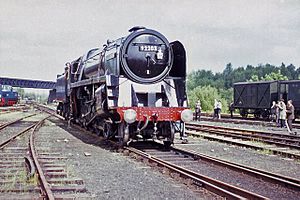
The original Woolmer Light Railway was officially approved by Parliament in 1902. In 1905, a new railway line opened, connecting Bordon to Bentley.
The War Office decided to make the Woolmer Light Railway a full-time training railway. They brought in more Royal Engineers to help. Because the original railway had very steep slopes, the Royal Engineers planned a new route for a standard-gauge railway (4 ft 8 1⁄2 in (1,435 mm) wide). This new line ran closer to the Whitehill – Greatham road.
Workshops and a locomotive shed were built at Longmoor. Some materials even came from an old military railway built in Sudan in the 1880s! After the line was converted and relaid in 1907, it became known as the Woolmer Instructional Military Railway from 1908. When an extension to Liss opened in 1933, it was renamed the Longmoor Military Railway in 1935.
The railway was mainly a single track, running north to south. But from 1942, an extra loop was added. This allowed trains to run in a circle, which was great for training. As a training railway, it was often being built or taken apart for practice.
Bordon Camp Facilities
Bordon Post Office
Mail was very important for soldiers' spirits. So, a post office was set up in Quebec barracks for all of Bordon and Longmoor. In 1908, it moved to a new brick building and was renamed Bordon Post Office. This is still where the local Royal Mail depot and combined army and civilian post office are today.
Soldiers' Institutes
In 1904, the Church of England Soldiers Institute opened. It was a corrugated iron building that cost £1,500. It was "open to all soldiers and sailors... regardless of religion." A large hall was added in 1906, big enough for 500 people. It had a stage and could be used for entertainment or religious services. This building was closed and taken down in 1960. A Tesco, One Stop convenience store is there now.
The Wesleyan Soldiers Home opened in 1905. It was a wooden building with a dark green roof. It had a games room, a reading room, and a lecture hall for 300 people. It also had bedrooms for visitors and a chaplain. Like the other institute, it was closed and taken down in 1960.
Bordon Officers' Sports Club
In 1910, a cricket ground and pavilion were built. The club house was built in 1922 by local officers. It had rooms for smoking, dining, and changing. Over time, more facilities were added, including two squash courts, a badminton court, tennis courts, a polo field, and hockey and rugby grounds. In 1980, the club was handed over to a civilian committee and became the Bordon and Oakhanger Sports Club.
Empire Club
The Empire Club opened in 1913. It had a gardener, tennis courts, and a bowling green. It was profitable during and after World War I. In 1938, Bordon Entertainments Ltd took over the club. After World War II, a competing club opened. So, the Empire Club added improvements like a cinema, a new ballroom, a bar, and even a lido (outdoor swimming pool) in 1963. In 1977, the club's lease went back to the local council. Sadly, the club burned down in 1987. The site is now civilian homes.
Medical Facilities
The original medical and dental centres were replaced in 1964 by a new building. It was nicknamed the "Mississippi Steamboat" because of its shape and large chimney. A new medical centre is now being built to replace it.
Schooling for Military Families
In 1906, a junior school and an infant school were built. The infant school was used for military lessons in the mornings and schooling in the afternoons. Before 1944, the military controlled these schools. After that, they were managed by Hampshire County Council. New schools were built in the 1960s and 1970s. One old school building, named Barbados House, is now the Phoenix Theatre.
Fire Station History
A fire station was on site from 1906. It was staffed by trained soldiers from each unit. It had a horse-drawn pump and three stables. From 1920, it had a motorised Thornycroft fire engine. The building also housed a section of the Royal Military Police.
Although a civilian fire station took over in 1938, the military fire station reopened at the start of World War II. Its fire engines were upgraded to new Leyland Motors lorries in 1940.
After the war, the station continued to serve both the army and local civilians. From 1958, it was staffed by civilians and had Green Goddess fire engines. These were replaced in 1973. In 1989, after a new civilian fire station was built in Bordon, the Royal Air Force took over the old building. It closed in 2005.
Religious Facilities
The Tin Tabernacle Church
Church of England services were first held in the gym, then in the C. of E. Soldiers Institute. In February 1921, St. George's Garrison Church was built. It was known as the Tin Tabernacle because it had a corrugated iron shell over a wooden frame. Its organ and furniture came from an old army base in Ireland. The church was taken down in 1983.
Sacred Heart Roman Catholic Church
There has been a Roman Catholic place of worship at the camp since Bordon opened. At first, the priest used a portable altar. Later, a wooden hut was used as Sacred Heart Church. This was taken down in 1990, and a new brick church was built.
The Reredos Painting
The Church of England church housed a special painting called a reredos. This altarpiece was a memorial to all the army units that served in Bordon. The painting shows Jesus Christ with four soldiers from different wars: the South African War, the First and Second World Wars, and the Korean War. A chaplain is giving a blessing. In the background, you can see all the different army groups that served in Bordon.
This painting was dedicated on July 22, 1964. It belongs to St. George's Garrison Church.
Bordon Military Cemetery
A military cemetery opened in April 1910 on Bolley Avenue. It was blessed by the chaplain-general of the forces.
Any serving member of the armed forces and their family can be buried here. This includes Canadian and South African soldiers who were at Bordon during the two world wars. It also temporarily held the graves of nine United States Army soldiers, who were later returned to the US. There are separate areas for different religions. One civilian, Mrs Alice Emily Chandler, is buried here. She was killed by a Luftwaffe bomb in 1940.
The Commonwealth War Graves Commission looks after the graves of 186 Commonwealth soldiers from World War I and 8 from World War II. These include 68 British, 27 South African, and 25 Canadian soldiers.
Memorial
A special stone was put up in June 1985 by the Canadian Forces. It is on the site of the old Tin Tabernacle. This stone remembers all the members of the Canadian Army who served in Bordon during both world wars. The maple leaf, a symbol of Canada, was even used in the logo of 4 Battalion REME.
Images for kids



